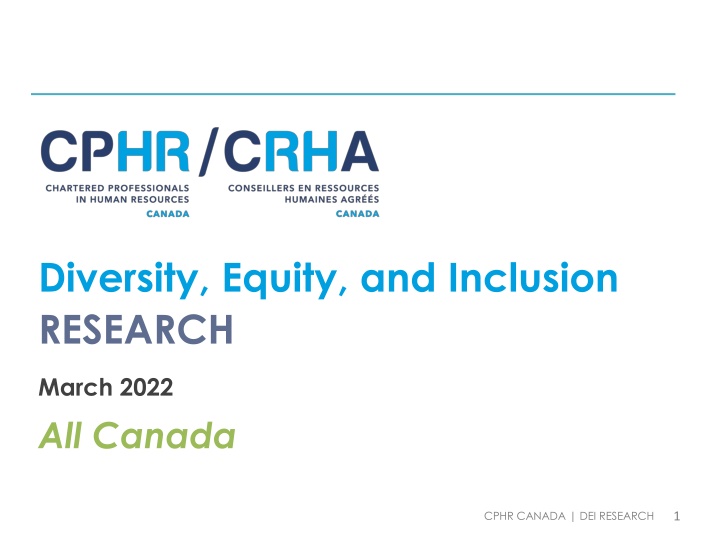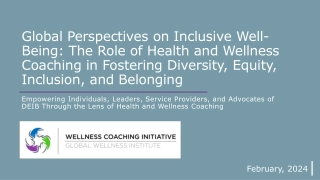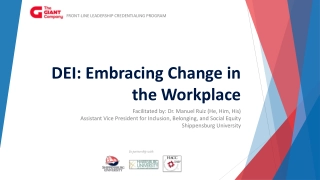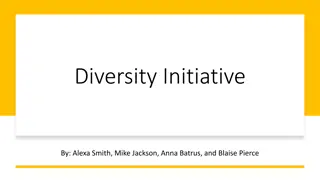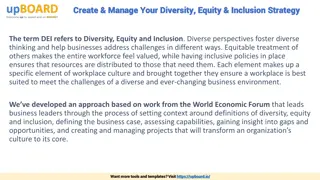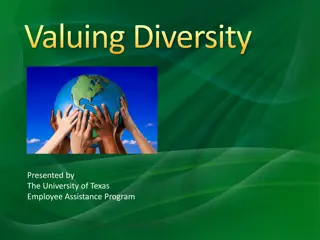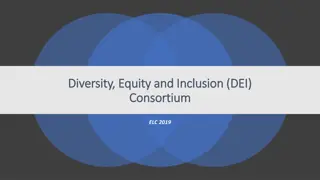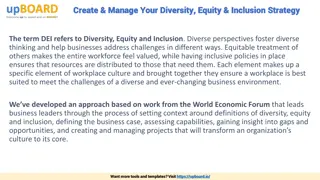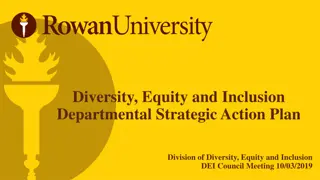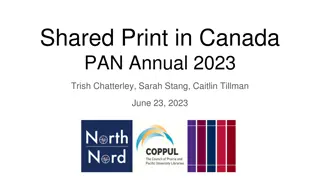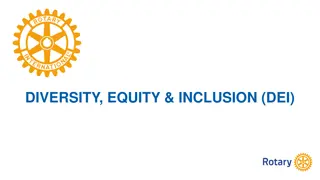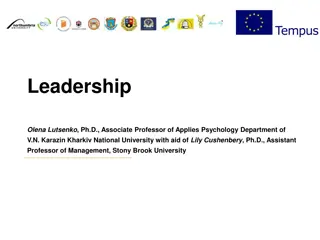DEI Research Insights: Leadership Diversity in Canadian Organizations
This research report presents insights on diversity, equity, and inclusion (DEI) in Canadian organizations, focusing on senior leadership structures and demographics. It highlights the challenges and opportunities for creating a more inclusive workplace, with data on gender representation, workplace characteristics, mental health challenges, and more.
Download Presentation

Please find below an Image/Link to download the presentation.
The content on the website is provided AS IS for your information and personal use only. It may not be sold, licensed, or shared on other websites without obtaining consent from the author.If you encounter any issues during the download, it is possible that the publisher has removed the file from their server.
You are allowed to download the files provided on this website for personal or commercial use, subject to the condition that they are used lawfully. All files are the property of their respective owners.
The content on the website is provided AS IS for your information and personal use only. It may not be sold, licensed, or shared on other websites without obtaining consent from the author.
E N D
Presentation Transcript
Diversity, Equity, and Inclusion RESEARCH March 2022 All Canada CPHR CANADA | DEI RESEARCH 1
Contents 3 Methodology 6 Insights 16 Benefits of DEI 21 Role of Leadership 25 Recruitment 29 Corporate Culture 2
Methodology Survey Type Online Survey Length 9 min Screeners Human Resources Professionals # Completed Surveys 1,328 Dates of Interviews Jan-Feb 2023 Note: This report is designed to highlight selected insights from the research. Full data tables are available in the topline reports. 3
Demographics Age Gender Role in HR Authorize/ final decision-maker Recommend/ part of 59% 30% Female 79% 43% process Male 17% 27% Consult/ influence decisions 18% Other 11% 11% 3% Minimal involvement 7% Prefer not to disclose 3% No Influence 18-27 28-39 40-59 60+ 2% Work Location Characteristics Learned English as a second/third+ language (non-mother tongue) Raised or educated outside of Canada Total Canada 16% 15% or United States 14% Mental health challenge that interferes with work /neurodiverse Workplace Home 12% 35% lgbtqia2s+ 7% Member of a religion that experiences 6% discrimination Hybrid Have an evident physical or health challenge/disability 5% 51% None of these 55% Total Canada (n=1328) 4
SENIOR LEADERSHIP STRUCTURE: Diversity in senior leadership Among the HR professionals surveyed, only 18% describe the senior leadership of their organization as Well-diversified; the majority describe their senior leadership as Acting towards (29%) or Aspiring (43%) Senior Leadership Well-diversified There is representation from several of the groups above Gen Z* 24% Mill 10% GenX 9% Boom 5% 18% Acting towards Definite formal plans to address diversity with some diverse 29% representation Aspiring Mostly not diverse, making attempts to diversify 43% Not diversified Mostly not diverse with no apparent interest in change Gen Z* 10% Mill 16% GenX 17% Boom 35% 10% CPHR CANADA | DEI RESEARCH 5 5. How would you describe the senior leadership of your organization when it comes to diversity?
INSIGHTS 6
WHY DEI? Part I: The UPSIDE of Investing in DEI What is the VALUE of DEI? HR professionals say the benefits of inclusiveness include: 82% Better workplace culture More innovation/creativity (especially for Gen Z and Millennials in HR) By showing the organizational benefits of DEI, HR professionals can prove it is key to a healthy workplace culture. 68% Doing the right thing/being authentic in the workplace 66% Position inclusiveness as a core competency to make it a priority, and less vulnerable to budget cuts CPHR CANADA | DEI RESEARCH 7 4. What are the key organizational benefits of working in a fully inclusive work environment?
WHY DEI? Part II: The DOWNSIDE of Ignoring DEI What is the COST of ignoring DEI? HR professionals say the threats of not addressing DEI include: The risk of homogeneity group think 70% Losing access to the best new talent Management may be surprised to learn that the greatest threat of ignoring DEI is not to reputation, but to core competencies and access to talent 61% Losing good current employees 55% Remind management that ignoring DEI can mean losing access to the skillsets of existing and prospective employees CPHR CANADA | DEI RESEARCH 8 10. Which of the following do you see as the biggest threats if your organization does not address diversity equity and inclusion?
LIMITS TO DEI Impact on Sentiment of DEI Efforts Can there be TOO MUCH DEI? % of Sentimental Impact of Company Efforts to Increase DEI 3% 15% More positive Slightly more positive No impact whatsoever Repellent Least diversified companies 81% 19% 63% At some point, DEI efforts appear to reach their goals; while poorly diversified companies can raise morale through much-needed efforts, the effect will be far weaker among the already diversified 3% More positive Slightly more positive No impact whatsoever Repellent Most diversified companies 37% 43% 61% 18% Diminishing marginal returns; for well-diversified companies, further DEI efforts will have less of an effect than for less- diversified companies CPHR CANADA | DEI RESEARCH 9 20. Thinking about the answer you gave above, what impact would it have on your sentiments if the company you worked for was making significant efforts in increasing Diversity, Equity and Inclusion?
BEST PRACTICES How to Implement an Effective DEI Strategy What STEPS should HR tell their company to take? HR professionals at the most diversified companies suggest: Senior leadership support in backing the initiative 81% Hiring new talent from diverse communities 70% HR professionals at diversified companies believe DEI starts at the top; while all employees play a role, leadership support is key Diversity/inclusivity/bias training/mgmt programs (for employees and management) 67% Having a game plan to implement a DEI strategy helps HR professionals help their companies CPHR CANADA | DEI RESEARCH 10 11. Which of the following steps are most important for an organization to implement an effective DEI (diversity equity and inclusion) strategy (even if your organization is not using them)?
BEST PRACTICES Effecting Change HR professionals at the least diversified companies suggest: What really makes a DIFFERENCE? Hiring diverse talent at senior levels 54% Promoting diverse talent to senior levels 52% HR professionals who need real change believe it is key that senior leadership become more diverse, either through hiring or promotion Mandatory diversity, anti racism training to produce systemic change 45% Real change starts at the top; for companies looking to increase diversity, senior leadership is the most effective place to start CPHR CANADA | DEI RESEARCH 11 12. Which of the following do you think would be most likely to bring change in your company? (Select all that apply if this is not currently happening at your company.)
BEST PRACTICES How to Signal Real Change HR professionals rate their DEI plans: How do you show that DEI programs are AUTHENTIC? Effective/helping to advance culture of diversity/diversity to senior management Non-existent Communication & training only/ no real actions 10% 33% 20% Communication and training aren t enough; assembling a diverse senior management team shows real action 37% A real attempt, but lacking action/change in senior management composition How does your company rate? Talk is cheap; if senior management isn t diverse, other efforts may be interpreted as lacking or disingenuous CPHR CANADA | DEI RESEARCH 12 7. Would you say that your organization s diversity plans are .
ROLE OF LEADERSHIP: Accountability HR professionals suggest the following are accountable for DEI: Who is Senior Leadership (Including Chief Diversity Officer or equivalent) ACCOUNTABLE for DEI? 82% 61% While most HR professionals say senior leadership is ultimately responsible for DEI, many also see their own department, and other employees, as playing a key role HR department overall 49% Employees/staff The buck stops here; senior leadership plays a key role in enacting DEI plans, but many HR professionals believe accountability extends to all company employees CPHR CANADA | DEI RESEARCH 13 8. Thinking about your organization s diversity equity and inclusion plans, who do you see as accountable for them being enacted in a meaningful way?
RETENTION: Retaining Talent Aside from exit interviews, HR professionals at the most diversified companies suggest: The RIGHT WAY to Retain Talent Leadership promotion from within 65% Onboarding/mentorship/ allyship designed to make employees feel welcome and valued When trying to retain talent from marginalized communities, what are the most diverse companies doing differently? An emphasis on promotion and mentorship 60% 60% Celebrate cultural occasions Get ahead of the curve;don t wait for exit interviews to find out how to retain talent, learn right now from what the experts are doing right CPHR CANADA | DEI RESEARCH 14 14. Which of the following is your organization doing to retain talent specifically from traditionally marginalized communities?
RETENTION : Retaining Key People Is Diversity the Secret to RETENTION? % of HR professionals who agree key people tend to stay with their organization: Least diversified companies 32% 40% 19% 9% More diverse companies are likelier to retain key people. Is this due to their inclusiveness? Or is diversity one of many benefits of a company with a healthy work environment Agree completely Agree somewhat Disagree somewhat Disagree completely Most diversified companies 6% 1% 52% 41% Agree completely Agree somewhat Disagree completely Disagree somewhat Whether cause or correlation, diversity is at the very least a sign of a healthy company, and perhaps a key driver CPHR CANADA | DEI RESEARCH 15 18. Key people tend to stay with the organization: Please rate the following regarding your organization:
BENEFITS OF DEI: Organizational Benefits Almost all HR professionals cite at least one organizational benefit of working in a fully inclusive work environment; the top benefit is a better workplace culture Those in companies with Aspiring and Acting senior leadership are more likely than those with Well-diversified senior leadership to mention many of the benefits below; women are more likely to see benefits than men Benefits 82% Better workplace culture Gen Z* Mill 79% GenX Boom 69% 68% More innovation/creativity 70% 59% Doing the right thing/being authentic in the 66% workplace 64% Employee morale and loyalty Company reputation/reduced perception of discrimination/inequity 60% East 63% PQ 37% West 59% 57% Improved collaboration 55% Access to the highest quality employees 52% Understand clients/customers better 59% 30% 55% 50% Better decision making 60% 27% 53% 27% Higher revenue/more clients/business success 1% None CPHR CANADA | DEI RESEARCH 17 4. What are the key organizational benefits of working in a fully inclusive work environment?
BENEFITS OF DEI: Best Practices Keys to Implementation Almost all HR professionals cite at least one tactic that is key to implementing an effective DEI strategy Top tactics include senior leadership support, formal DEI training (including for senior management) Keys to Implementation 82% Senior leadership support in backing the initiative Formal diversity/inclusivity/unconscious bias training & mgmt programs for all employees including sr mgmt 73% 63% Hiring new talent from diverse communities Gen Z* Mill GenX Boom 66% 56% Creating diversity/inclusivity committees/taskforces/ networks/affinity groups/safe space to discuss 56% 59% 45% 50% DEI strategy is led by diverse leaders 62% 56% 48% 40% 50% Creating mentoring/allyship opportunities East 34% PQ 50% West 33% 36% Ensure talent slates are more diverse 34% Partnering with outside diverse talent initiatives 29% Performance measures and incentives for leaders 21% Hiring a dedicated diversity officer 14% Select vendors based on their DEI performance 2% None of these CPHR CANADA | DEI RESEARCH 18 11. Which of the following steps are most important for an organization to implement an effective DEI (diversity equity and inclusion) strategy (even if your organization is not using them)?
BENEFITS OF DEI: Best Practices Strategies for Bringing Change Diversity at senior levels, through hiring or promotion, is most commonly viewed as likely to bring change Those in companies with less diverse leadership are most likely to emphasize the importance of diverse leadership in bringing change Tactics for Change East PQ West 54% Hiring diverse talent at senior levels 67% 46% 53% 49% 58% 39% 49% Promoting diverse talent to senior levels Mandatory diversity, anti racism training to produce systemic change 46% 46% Setting diversity goals and targets 38% Senior level mentoring to diverse talent specifically 35% Specific retention strategies for diverse hires Diversity goals are directly tied to executive compensation and advancement 27% A role of diversity specialist (job function with a minimum of 25%+ DEI related) 21% Making a public pledge to increase senior level 18% diversity None of these there are no actions that will bring 3% change in this company CPHR CANADA | DEI RESEARCH 19 12. Which of the following do you think would be most likely to bring change in your company? (Select all that apply if this is not currently happening at your company.)
BENEFITS OF DEI: Perceived Threats of Failing to Address DEI Among those whose leadership is not Well-diversified, there is significant concern about the lack of diversity Possible damage to the core abilities of the organization (group think, losing talent) are perceived as a greater threat than reputational risks Concern over lack of diversity in senior leadership Not at all Concerned Not very Concerned Very Concerned Somewhat Concerned 18% 50% 27% 5% PQ: 41% Concerned: 68% Perceived threats Gen Z* Mill GenX Boom 88% 74% The risk of homogeneity group think 70% 70% 60% Losing access to the best new talent 61% Losing good current employees 55% Reputational risk and image management 52% East 40% 26% 37% 62% 42% 34% 26% PQ West Gen Z* Mill GenX Boom Falling behind the competition 36% The risk of overconfidence loss of creativity 33% Losing clients/customers 15% None of these, we can be a successful business without 3% addressing diversity CPHR CANADA | DEI RESEARCH 20 9. How concerned are you about the lack of diversity in senior leadership at your organization? 10. Which of the following do you see as the biggest threats if your organization does not address diversity equity and inclusion?
ROLE OF LEADERSHIP Makeup of organization Among those at companies with Acting towards or Well-diversified senior leadership, most say women are represented in senior leadership Any Those in Well-diversified companies are more likely to say women aged 55+ are represented 97% Represented Groups 77% 80% Women overall 55% 66% Those who speak more than 1 language 61% 52% Those who identify as Racialized, Black, and/or People of colour or other non-European ethnicity 47% 65% Women aged 55+ 23% 31% Indigenous Peoples including First Nations, M tis East 28% 12% 30% PQ West and Inuit 22% 32% lgbtqia2s+ and/or gender and sexually diverse individuals 15% 31% Member of a religion that experiences discrimination Senior Leadership 14% 23% People with disabilities (including invisible and Well-diversified episodic disabilities) Acting towards 11% 19% Mental health challenge that interferes with work / neurodiverse CPHR CANADA | DEI RESEARCH 22 6. As far as you know, which of the following groups are represented in the senior leadership at your organization?
ROLE OF LEADERSHIP: Current State of Engagement Most HR professionals say their organization s diversity plans are either effective or a real attempt Those in more diversified companies are much more likely to agree that their organization s diversity plans are at least a real attempt Perception of Diversity Plans Effective and are helping to advance a culture of diversity (including bringing diversity to senior management jobs) Non-existent Communication and training only, with no real actions that I have seen 10% Gen Z 24% Mill 29% GenX 33% Boom 44% 33% 20% 37% A real attempt, but lacking in action especially related to change in senior management composition 7. Would you say that your organization s diversity plans are . 23
ROLE OF LEADERSHIP: Accountability for DEI Senior leadership is most likely to be seen as accountable for DEI plans, regardless of diversity of senior leadership Those in companies with more diverse senior leadership are more likely to view all groups as accountable for enacting DEI plans in a meaningful way Accountable for DEI 62% 82% 83% Senior Leadership (Including Chief Diversity Officer or equivalent) East 90% PQ 78% West 81% 65% 61% 43% HR department overall 30% 49% 59% Employees/staff Senior Leadership Well-diversified 16% 11% 6% All Canada Clients/customers Not diversified CPHR CANADA | DEI RESEARCH 24 8. Thinking about your organization s diversity equity and inclusion plans, who do you see as accountable for them being enacted in a meaningful way?
RECRUITMENT 25
RECRUITMENT: Attracting a Diverse Candidate Pool: Top 5 Using inclusive language in job postings is the top tactic for attracting all available talent, regardless of diversity of senior leadership Those in Well-diversified companies are much more likely to also ensure hiring panels are diverse Tactics for Recruitment 68% 67% 50% Use inclusive language in job postings Senior Leadership 31% 52% Well-diversified All Canada 50% Highlight diversity on your career site Not diversified 56% 31% 49% Advertise your jobs and recruit through diverse channels /diverse job boards Gen Z* Mill 28% GenX Boom 49% 49% 56% 23% 45% 42% East 53% PQ 47% West 38% Highlight diversity in your job descriptions 16% 50% 37% Gen Z* Mill 14% GenX Boom 38% Hiring / interview panel is diverse 36% 38% 13. Which of the following is your company using to ensure that you are considering all available talent for the job? (Including BIPOC/women/neurodiverse/ 2SLGBTQ+) CPHR CANADA | DEI RESEARCH 26
RECRUITMENT: Retaining Talent from Marginalized Communities To retain talent from marginalized communities, those at Well-diversified companies are much more likely to promote from within and leverage onboarding/mentorship options Tactics for Retention 60% 49% 63% Exit interviews to understand why they are leaving 31% 60% 56% Celebrate cultural occasions (eg Black History Month, Asian Heritage Month, Truth & Reconciliation Day, Pride Month, etc ) East 59% 34% 61% PQ West 27% 58% 50% Flexibility/sensitivity to employees needs in terms of work hours/days/working from home 20% 65% 47% Leadership promotion from within 20% 53% 45% Investing in training - especially for junior staff 30% 55% 45% Celebrate anniversaries / milestones 24% 60% 43% Onboarding and mentorship/allyship process designed to make employees feel welcome and valued 24% 43% 35% Senior Leadership Competitive compensation that keeps pace with other offers Well-diversified 22% 44% 32% All Canada Toxic hires are terminated (regardless of level or other value to organization) Not diversified 12% 41% 28% East 34% PQ 14% West 30% Weekly/monthly/quarterly check ins with leadership/boss 14. Which of the following is your organization doing to retain talent specifically from traditionally marginalized communities? CPHR CANADA | DEI RESEARCH 27
RETENTION: Reasons for Leaving A lack of career advancement opportunities is the top reason for preventable loss of employees, regardless of diversity of senior leadership Preventable Reasons for Leaving 41% 65% 53% Lack of career advancement opportunities 26% 49% 41% Mental health challenges due to workload/stress trouble coping with work challenges 42% 23% 39% Gen Z* 66% Mill 44% GenX 38% Boom 25% Wanted more flexibility with work hours/ work-life balance issues 20% 37% 34% Increased workload without additional pay 45% 41% 33% 16% 18% 19% 22% Wanted to continue to work from home (our company is returning to the office) 10% 25% 15% Lack of mentorship 28% 20% 14% 9% 5% 17% 12% Lack of diversity and inclusion in the workplace/feeling Senior Leadership unwelcome or not valued Well-diversified 2% 17% 7% All Canada Lack of diverse/inclusive leadership and initiatives Not diversified 15. As far as you know have employees left your organization for any of the following reasons over the past 12 months? CPHR CANADA | DEI RESEARCH 28
CORPORATE CULTURE: Engagement Discrimination in the Workplace Frequency of Feeling Disengaged One-third of HR professionals at least sometimes feel less engaged at work due to discrimination Frequently Never Sometimes Rarely Always 2% 7% 23% 38% 31% Among those at Not diversified companies, over one-half says this means they spend time looking for another job At least sometimes: 32% Reactions to Feeling Disengaged 58% 44% I am not performing at my best level I am actively thinking about how to address the situation, 42% 47% instead of doing my job 40% 24% I care less about the success of the business overall 53% 18% Senior Leadership I spend time looking for another job Well-diversified 26% 41% I am talking to coworkers about the situation Not diversified 26% 21% I am considering leaving my profession completely 16. How often are you personally less engaged at work due to either institutional, interpersonal, structural and/or internalized systems of discrimination? 17. When you are less engaged at work due to discriminatory action/policies, how does this manifest at your job? CPHR CANADA | DEI RESEARCH 30
CORPORATE CULTURE: Engagement Impact on Sentiment of DEI Efforts Most HR professionals would feel more or slightly more positively about their job and working in HR if their company made significant efforts to increase DEI This is especially true of HR professionals at companies whose senior leadership is Not diversified Sentimental Impact of Company Efforts to Increase DEI Well-diversified Not diversified More positive Slightly more positive No impact whatsoever Repellent More positive Slightly more positive No impact whatsoever Repellent 3% 3% 15% 61% 37% 43% 81% 19% 63% 18% Gen Z Mill GenX Boom 79% 53% 0% 17% More positive No impact whatsoever 49% 22% 46% 30% 20. Thinking about the answer you gave above, what impact would it have on your sentiments if the company you worked for was making significant efforts in increasing Diversity, Equity and Inclusion? CPHR CANADA | DEI RESEARCH 31
CORPORATE CULTURE: Retaining Key People HR professionals at companies that are Well-diversified are more likely to agree that key people tend to stay with the organization Key people tend to stay with the organization ? Agree completely Agree somewhat Disagree somewhat Disagree completely Not 32% 40% 19% 9% diversified Agree: 72% Disagree somewhat Agree completely Agree somewhat Disagree completely Well- 52% 41% 6% 1% diversified Agree: 93% 18. Key people tend to stay with the organization: Please rate the following regarding your organization: CPHR CANADA | DEI RESEARCH 32
